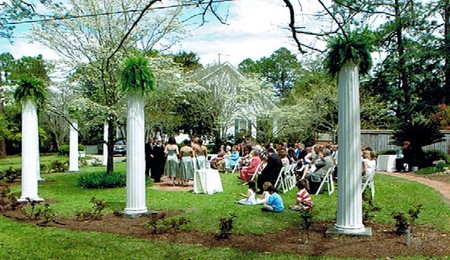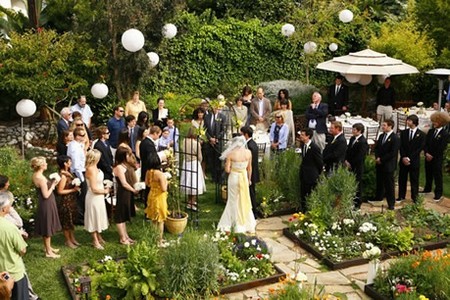I have left till last the very worst—the scenario that makes strong gardeners turn pale. It’s The Wedding. It may be your own child who surprises you with the determination to be married in the garden (the first whiff of interest in the garden in twenty-five years). Or perhaps back in the safety of winter, you generously offered your garden for a friend’s wedding. It seemed like a delightful idea back then but a cold, hard look at the garden today suggests that it was madness. This is no time for garden planning in exquisite detail. It’s April, and you’re up against reality. If you’re lucky you have four months, but it may be only three. Heroic measures are called for.
For a start, get going on whatever grass there is. Can it be turned into a lawn in time? Think short-term. Yes, it will be trampled, punctured by high heels, and scuffed by overexcited children. But face the fact that it has to look great only for the first and most formal hour of the wedding. After that it will be covered by people.
Begin now to feed it, water it, and mow it often. Frequent mowing at reasonable height will be your best chance; neglecting it until a few days before and setting the blade low will make any lawn look exactly what it is—scalped. Cut sharp edges around beds and borders next to the grass. It will smarten up the lawn and make an elegant and clean outline to frame the flowers.
Flowers?
Are you going to have flowers? If you decide not to get into any real planting, take a good look at what is out there. If the garden is limited to a few nice trees and some semi-nice shrubs, have them tidied up (short-term again, remember— no radical pruning this spring). Against this background of quiet green and your spiffy, well-fed lawn, consider using strategically placed containers of flowers in white and light pastel colors.
This is a garden article, so I will not be drawn into details better handled by a wedding consultant. One thing I will mention, however: use a soilless mix in the planters. Regular soil when watered will result in pots too heavy to move around.
Now back to the garden and things that grow in it.
If there are established flower beds, tidy them up, reduce the old clumps of perennials to attractive shape and size. With such a short lead time, you don’t want to throw out too many things. Even if they’re not what you would choose, they’ll have the effect of holding down the bed or border so that it won’t look like an instant garden trucked in the day before. Now prepare to fill the spaces in between with annuals, mostly started plants but a few direct-sown.
Do you know the colors of the old perennials, and whether they’re likely to be in bloom on The Day? You can tone down any “difficult” colors with carefully chosen annuals. Suppose you have an overexuberant perennial that verges on a bright magenta pink. Surround it with the delicate sprays of larkspur (Consolida ambigua) or sweet william (Dianthus barbatus) in old-fashioned mixed colors. If the wedding is to be later in the summer, petunias and impatiens, in white and pink shades, would last longer.
As early as you can, get out and about and renew or strike up acquaintance with local nurseries. You’re going to need a lot of annuals. This is not the time for heavy reds and purples; white, yellow, pink, light blue, and lavender are the colors you need. In April it may be early enough for you to put in an order for what you want. As soon as the weather warms up, you will be able to plant them out and tend them lovingly until the wedding. This will give them time to look established and, in any case, most nurseries would no longer have annuals for sale in July and August.
Don’t reject the idea of seeding a few fast-growing annuals directly into the border. They can make an attractive froth of color in generous amounts and at the same time help to keep you within your budget. Among fast-growing annuals for this purpose, I suggest annual baby’s breath (Gypsophila elegans), spider flower in white or pink (Cleome hasslerana ‘Helen Campbell’ is a good white), and pink or white Cosmos bipinnatus. The ‘Sensation’ series can reach four or five feet, and would be suitable for the rear of the bed. ‘Sonata’ is a shorter white, under two feet tall.
For the front of the bed, sweet alyssum (Lobularia maritima) is a good choice. It begins to bloom when it is only two inches high and just keeps on keeping on. Annual candytuft also grows very fast and is pretty in a mix of pink, rose, mauve, and white. A small, marvelously long-blooming zinnia, also low enough for the front of the border is Zinnia angustifolia (be sure to get the white, not the orange).
If, despite these efforts, you still see a few empty spaces, what do you do? Well, I once begged and borrowed potted plants from friends for just such a situation. There were geraniums, begonias, coleus, caladiums, and, to raise the tone a little, an urn of lily-of-the-Nile (Agapanthus). Everything was safely returned the next day. After all, what did Gertrude Jekyll do in August? She sent her gardeners to the greenhouse for pots of anything that would beautify her borders, and what was good enough for Miss Jekyll, I figured, was good enough for me.
Why, you ask, do I write with such feeling about garden weddings? There is nothing like a social function of this kind for making the garden’s shortcomings so painfully evident. After a number of years of garden consulting, I finally learned, and, at the initial meeting with a potential client, usually in March or April, I would ask the question: “And when, exactly, is the wedding?” Invariably, my question would be met with surprise and disbelief—”How did you know?”
Categories
Advertisements
Recent Articles
 How to Understand Bed Sizes – A Small Guide
How to Understand Bed Sizes – A Small Guide How to Select Some Must Have Kitchen Accessories
How to Select Some Must Have Kitchen Accessories Best Way to Change a Car Tire
Best Way to Change a Car Tire Best Way to Write an Affirmation
Best Way to Write an Affirmation Best Way to Take Charge of Your Financial Life
Best Way to Take Charge of Your Financial Life Best Way to Survive a Party When You Don’t Know Anyone
Best Way to Survive a Party When You Don’t Know Anyone Best Way to Stop Self Sabotaging Yourself
Best Way to Stop Self Sabotaging Yourself Best Way to Start Journal Writing
Best Way to Start Journal Writing Best Way to Speak with a Powerful Voice
Best Way to Speak with a Powerful Voice Best Way to Simplify Your Life
Best Way to Simplify Your Life Best Way to Respond to a Put-Down
Best Way to Respond to a Put-Down Best Way to Reduce Acne Breakouts
Best Way to Reduce Acne Breakouts Best Way to Recover from Dining Disasters
Best Way to Recover from Dining Disasters Best Way to Quit Your Job Gracefully
Best Way to Quit Your Job Gracefully Best Way to Make Your Own Website
Best Way to Make Your Own Website




Leave a Reply